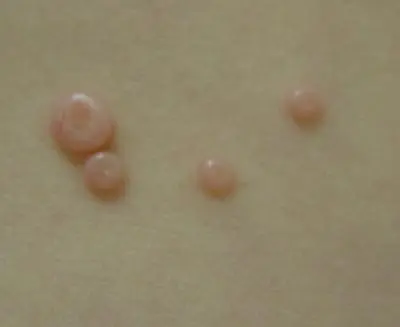Contents
Mollusc contagiosum virus (MCV) is a dermatological disease caused by a virus from the poxvirus family. As the name of the disease indicates, the virus is highly infectious. It most often attacks small children and adults with reduced immunity, people suffering from atopic dermatitis are also at high risk.
What is molluscum contagiosum and how to recognize it?
Molluscum contagiosum is a skin disease that is very easily caught. Infection can occur through droplets, as a result of direct contact, but also through contact with objects of an infected person, e.g. by using the same towel. As mentioned in the introduction, young children are often infected; many cases are also found in young adults, especially sexually active people.
In infected cells, the MCV virus multiplies dynamically, as a result of which they grow, burst and release infectious content. The lesions visible on the skin are smooth, pearly lumps or nodules of pink or white color and a diameter of approx. 5 mm; for 6-12 weeks the changes gradually increase in size. Sometimes a small depression is visible in the central part of the nodules and papules. The puncture of the lesion releases its contents – there are dead cells and virus particles here. Symptoms of molluscum contagiosum are so characteristic that the clinical picture of the disease is usually sufficient for the correct diagnosis. The cases where the changes are accompanied by inflammation are more difficult to diagnose. In such situations, the papules and nodules do not have a typical depression, the lesions are red.
What method of treating molluscum contagiosum to choose?
The molluscum contagiosum virus does not penetrate the blood. Symptoms are limited to the skin and infection is usually not serious. The problem is, however, the unsightly appearance of the lesions, and above all the fact that the patient can be contagious all the time. Therefore, it is recommended to implement the therapy as soon as possible. Several treatments are currently available for molluscum contagiosum.
Changes caused by MCV infection can be removed mechanically by curettage, electrocoagulation, laser burning or freezing (cryotherapy). Physically removing contagious mollusks can be painful, may cause bleeding and leave scarring markstherefore it is not recommended in children. The necessity to undergo several treatments with a dermatologist to remove all skin lesions is also a big obstacle.
In the treatment of infectious mollusks, pharmacotherapy is also used – pharmacy topical preparations based on 5% potassium hydroxide solution, 5% lactic acid and iodine tincture. However, the use of a 5% potassium hydroxide solution requires very high precision as it is a corrosive substance; application outside the affected tissue causes painful burns. Chemical ablation can also leave scars and discoloration, so it is not recommended to use this method for lesions located on the face or mucous membranes.. A significant contraindication to the use of the above-mentioned of the products is atopic dermatitis, which, unfortunately, often accompanies molluscum contagiosum.
Natural treatment for molluscum contagiosum
In search of non-invasive, safe methods of fighting mollusc contagiosum, it is worth turning to nature. Mollusan®MED is composed of natural ingredients (essential oils) and is non-corrosive, therefore it does not cause irritation, and its use is painless and does not pose a risk of scarring. Systematic treatment with the preparation allows you to remove changes caused by the mollusc mollusc virus within 3-4 weeks. The fluid can be used to treat children and people who struggle with other dermatological problems, including atopic dermatitis.
How to protect yourself from molluscum contagiosum infection?
So far, no vaccine against MCV has been developed. Prophylaxis should include taking care of personal hygiene and avoiding the use of shared towels and clothes, especially underwear. People infected with mollusks should avoid scratching the lumps and nodules as the virus spreads easily, forming larger clusters around previous individual lesions.
Sponsored article










